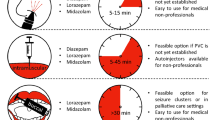Summary
The phenytoin plasma levels were measured in 45 epileptic patients whose only treatment was phenytoin. The plasma of 20 other patients receiving both phenytoin and phenobarbital was also tested for the concentration of these two drugs and 18 patients treated with phenytoin, phenobarbital and primidone were investigated in the same way.
The results were used to calculate the plasma levels of phenytoin in relation to dosage and to measure the effect of the simultaneous use of phenobarbital on the phenytoin plasma levels and of primidone together with phenobarbital on phenytoin concentration.
The results led to the following conclusions:
The population of epileptic patients can be divided into 2 groups. In the first group the patients reach equilibrium at the relatively high phenytoin plasma level for a given dose of phenytoin, and in the second group the phenytoin plasma level tends to be significantly lower for parallel dosages. Both groups, in their behavior, obey mathematically an exponential graph specific for each group.
Phenobarbital tends to lower the plasma phenytoin level when the two drugs are used simultaneously. It is also possible, by the graphs produced, to calculate the expected phenytoin plasma levels when using the drugs together.
Primidone and phenobarbital together decrease the phenytoin level much more than expected from the effect of phenobarbital alone.
Zusammenfassung
Die Plasmakonzentration von Phenytoin wurde bei 45 Epileptikern, die nur dieses Medikament erhielten, bestimmt. Bei 20 weiteren Patienten, die auch Phenobarbital erhielten, wurde im Serum Dekonzentration der beiden Antiepileptika, bei 18 Patienten, die außerdem auch Primidon einnahmen, Dekonzentration der drei Medikamente bestimmt.
Es wurde die Plasmakonzentration von Phenytoin auf die eingenommene Medikamentendosis bezogen und der Einfluß der gleichzeitigen Einnahme von Phenobarbital bzw. sowohl von Phenobarbital wie auch von Primidon auf die Phenytoinkonzentration analysiert.
Aufgrund der eigenen Untersuchungsergebnisse können folgende Schlußfolgerungen gezogen werden:
-
1.
Die Epileptiker können mit Bezug auf die Phenytoinkonzentration im Serum in zwei Gruppen unterteilt werden. In einer ersten Gruppe wird ein Gleichgewicht bei einem relativ hohen Phenytoinspiegel im Serum, bezogen auf eine bestimmte Medikamentendosierung, erreicht, in einer zweiten Gruppe besteht die Tendenz zu einer deutlich niedrigeren Plasmakonzentration bei gleicher Dosis. Beide Gruppen entsprechen ihrem Verhalten mathematisch einer exponentiellen Kurve, die für jede Gruppe spezifisch ist.
-
2.
Bei gleichzeitiger Einnahme mit Phenytoin senkt Phenobarbital tendenzmäßig den Phenytoin-Plasmaspiegel. Aufgrund der vorgelegten Kurvenbilder kann man den zu erwartenden Phenytoinspiegel bei gleichzeitiger Verwendung beider Medikamente errechnen.
-
3.
Wenn zusätzlich zum Phenytoin sowohl Primidone als auch Phenobarbital gegeben werden, senkt dies den Phenytoinspiegel weit mehr, als aus der alleinigen Gabe von Phenobarbital zu erwarten wäre.
Similar content being viewed by others
References
Booker, H. F., Tormey, A., Toussaint, J.: Concurrent administration of phenobarbital and diphenylhydantoin, lack of an interference effect. Neurology (Minneap.) 17, 383–385 (1971)
Bochner, F., Hooper, W. D., Tyrer, J. H., Eadie, M. J.: Effect of dosage increments on blood phenytoin concentration. J. Neurol. Neurosurg. Psychiat. 35, 873–876 (1972)
Buchanan, R. A., Haffelfinger, J. C., Weiss, C. F.: The effect of phenobarbital on diphenylhydantoin metabolism in children. Pediatrics 43, 114–116 (1969)
Cucinell, S. A., Conney, A. H., Sansur, M., Burns, J. Y.: Drug interaction in man. 1. Lowering effect of phenobarbital on plasma levels of bishydroxycoumarin (Dicoumarol) and diphenylhydantoin (Dilantin). Clin. Pharmacol. Ther. 6, 420–429 (1965)
Cucinell, S. A., Koster, R., Conney, A. H., Burns, J. Y.: Stimulatory effect of phenobarbital on the metabolism of diphenylhydantoin. J. Pharmacol. Exp. Ther. 141, 157–160 (1963)
Eadie, M. Y., Tyrer, J. H., Hooper, W. D.: Diphenylhydantoin dosage. Proc. Aust. Assoc. Neurol. 10, 53–59 (1973)
Garettson, L. K., Dayton, P. G.: Disappearance of phenobarbital and diphenylhydantoin from serum of children. Clin. Pharmacol. Ther. 11, 674–679 (1970)
Gruber, C. M., Mosdier, J. M., Grant, P., Gleu, R.: Objective comparison of phenobarbital and diphenylhydantoin in epileptic patients. Neurology (Minneap.) 6, 640–645 (1956)
Herishanu, Y., Eylath, U.: On the diphenylhydantoin metabolism (in preparation, 1977)
Herishanu, Y., Eylath, U.: Plasma diphenylhydantoin concentration in epileptic patients. Harefuah 87, 251–253 (1974)
Izumi, N.: Studies on phenobarbital and diphenylhydantoin in the plasma and phenobarbital in the cerebrospinal fluid. Acta Pediatr. Jap. 74, 539–551 (1970)
Kristensen, M., Hansen, J. M., Skovsted, L.: The influence of phenobarbital on the half-life of diphenylhydantoin in man. Acta med. Scand. 185, 347–350 (1969)
Kutt, H., Haynes, J., Verebely, K., McDowell, F.: The effect of phenobarbital on plasma diphenylhydantoin level and metabolism in man and in rat liver microsomes. Neurology (Minneap.) 19, 611–616 (1969)
Kutt, H., Fouts, Y. R.: Diphenylhydantoin metabolism by rat liver microsomes and some of the effects of drugs or chemical pretreatment on diphenylhydantoin metabolism by rat liver microsomal preparation. J. Pharmacol. Exp. Ther. 176, 11–26 (1971)
Lund, L., Alvan, G.: Phenytoin dosage nomogram. Lancet 1975 II, 1305
Morselli, P. L., Rizzo, M., Garattini, S.: Interaction between phenobarbital and diphenylhydantoin in animals and in epileptic patients. Ann. N.Y. Acad. Sci. 179, 88–107 (1971)
Richens, A., Dunlop, A.: Phenytoin dosage nomogram. Lancet 1975 II, 1305–1306
Sotaniemi, E., Arvela, P., Hakkarainen, H., Huhti, E.: The clinical significance of microsomal enzyme induction in the therapy of epileptic patients. Ann. Clin. Res. 2, 223–227 (1970)
Stensrud, P. A., Palmer, A.: Serum phenytoin determinations in epileptics. Epilepsia 5, 364–370 (1964)
Svensmark, O., Schiller, P. Y., Buchthal, F.: 5,5-diphenylhydantoin (Dilantin) blood levels after oral or intravenous dosage in man. Acta pharmacol. (København) 16, 331–346 (1960)
Toseland, P. A.: Le dosage des médicaments anticonvulsants dans les liquides biologiques. Problèmes posés par leur administration. Therapie 28, 993–1002 (1973)
Triedman, H. M., Fishman, R. A., Yahr, M. D.: Determination of plasma and cerebrospinal fluid levels of Dilantin in the human. Trans. Am. Neurol. Assoc. 85, 166–170 (1960)
Author information
Authors and Affiliations
Rights and permissions
About this article
Cite this article
Abarbanel, J., Herishanu, Y., Rosenberg, P. et al. In vivo interaction of anticonvulsant drugs. J Neurol. 218, 137–144 (1978). https://doi.org/10.1007/BF00313070
Received:
Issue Date:
DOI: https://doi.org/10.1007/BF00313070




